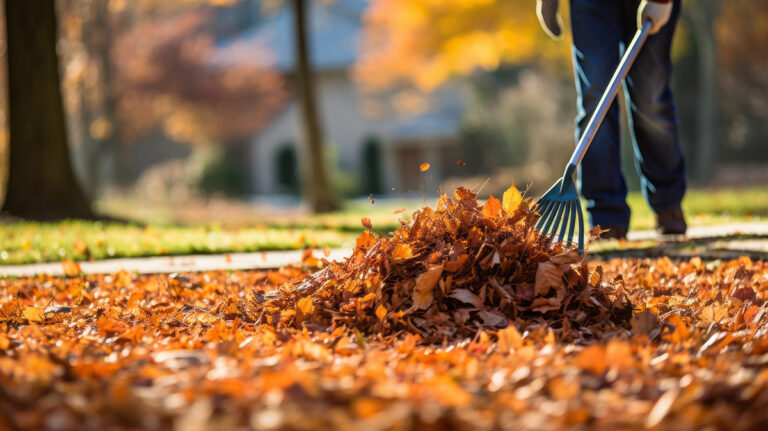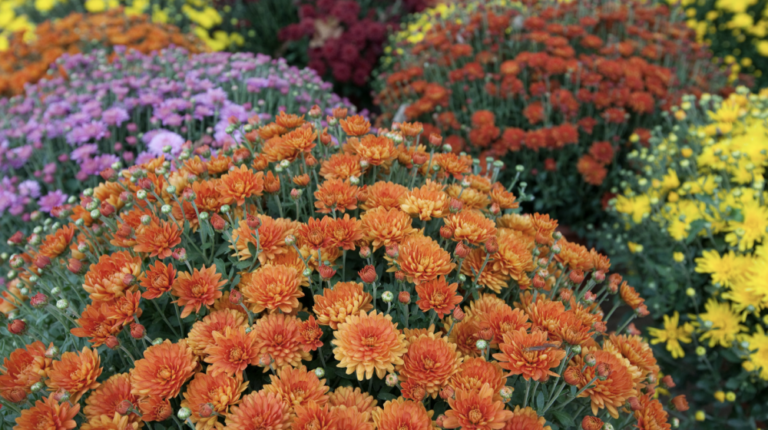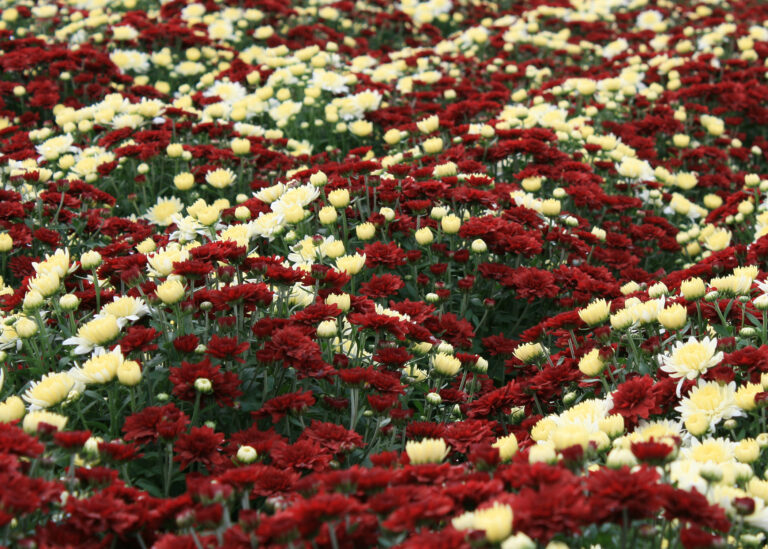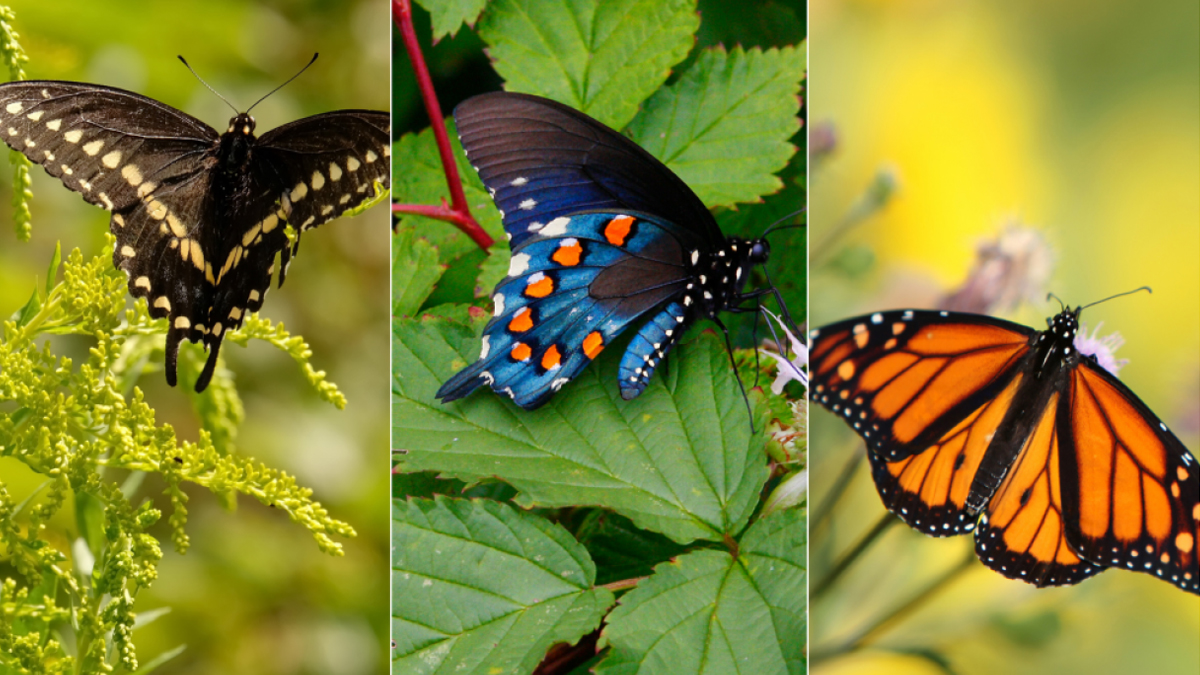
by Bronwynne Bailey, Lafayette County Master Gardener

The Lafayette County Master Gardeners are pleased to welcome the public to their Annual Spring Lecture Series which will be held in the Dotsy A. Fitts Auditorium of the Public Library on 401 Bramlett Boulevard. Parking is available at the library or across the street at the Oxford Skate Park. Our next speaker will be Dr. Brice Noonan, Professor of Biology at the University of Mississippi who will provide a lecture on “Your Big Backyard… All Its Wonderful Reptiles and Amphibians” on April 13 at noon. This talk will be beneficial for anyone interested in identifying snakes and amphibians inhabiting your garden. For more information or questions follow us on Instagram or Facebook, visit our website at http://www.lcmga.org/ or call the MSU Extension office at 662-234-4451.
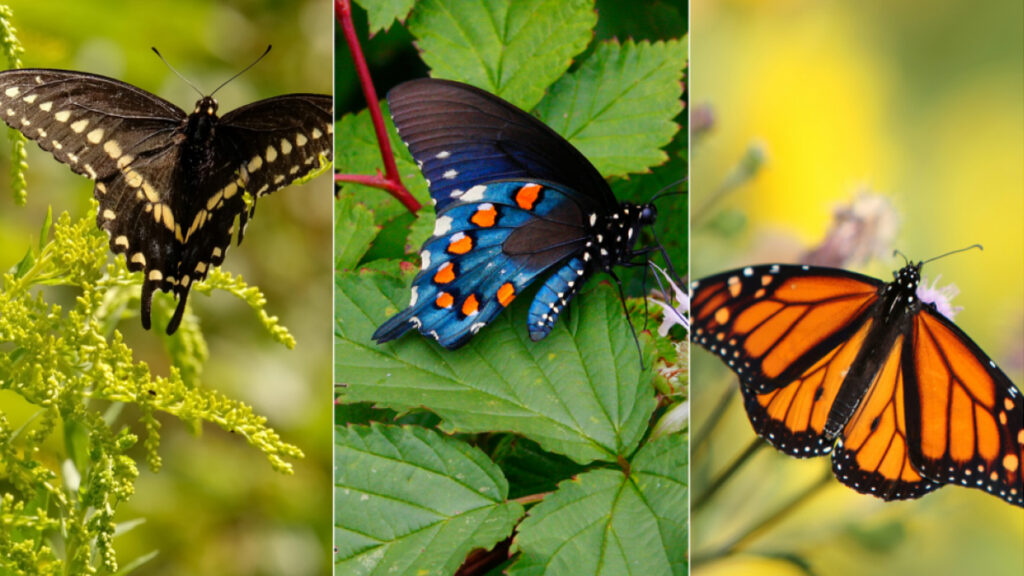
Milkweed to Help Welcome Monarch Butterflies
I woke up to a shower of yellow pollen on my car this week, the true sign that spring is on its way! Most gardens and landscapes are planned for either beauty or value. We want to see the vibrant colors of flowers, smell their fragrance, and eat fresh fruit and produce that we have grown. There are other reasons to choose a plant for your garden. One rewarding goal is to attract butterflies and other pollinators. Butterflies provide a beautiful component in the landscape with their numerous colors, sizes, and shapes. They also benefit the gardener by pollinating many flowers, shrubs, vines, and other woody plants. The key to attracting butterflies is to simply provide their food sources and other living needs for the adult and caterpillar stages. While providing for these needs, you can create a beautiful flowering garden. Today, I want to talk about how to make your landscape welcoming to monarch butterflies.
You easily recognize the brilliant coloring of the large monarch butterflies. They have two sets of deep-orange wings with black borders and veins and white spots along the edges. As a caterpillar, it is striped in yellow, black, and white bands and reaches up to 2 inches long before it becomes a light-green chrysalis with tiny yellow spots.
Butterflies need shelter from wind and rain and a roosting place for the night. Shrub foliage is often used for protection and sleeping quarters. Create a butterfly shelter area by constructing a simple log pile in a corner of the back yard. Simply stack cut logs anywhere from 3 to 5 feet high. Flat stones placed in open, sunny areas of the garden give butterflies an area to warm up on cool mornings. They will also use brick or concrete patios, sidewalks, or decks for basking.
Benefits
Who doesn’t love having butterflies in their garden? Monarch butterflies need milkweed for food and reproduction. Milkweed is essential to help boost declining monarch butterfly populations and can provide nectar for a wide variety of pollinators.
Varieties
There are fifteen butterfly weed species native to Mississippi and seed is available from various online seed companies. They are easy to start from seed in your own in containers until they are ready for transplant. Butterfly weed grows up to 3 feet tall and 2 feet wide and has an upright, clumping growth habit. The clusters of tubular flowers come in various shades of orange, but some flowers are shaded towards yellow or red.
Asclepias verticillata (Whorled Milkweed) blooms from May to September, forming flat-topped clusters of small greenish-white flowers on the end of each stem. The flowers attract various insects, including bees, wasps, butterflies, skippers, beetles, and flies. Whorled Milkweed is still a welcome host plant for Monarch Butterfly caterpillars despite its unique appearance. Since this species is one of the last milkweeds to die back in the fall, it’s a great late-season host for Monarchs preparing to migrate south! This delicate-looking wildflower can easily grow from seed, but it may not flower the first year. It can be grown in full sun or partial shade. Whorled Milkweed thrives in various habitats, including fields, pastures, roadsides, dry prairies, dry slopes, woodlands, and meadows. Unfortunately, it’s highly poisonous to livestock and is considered a nuisance weed in agricultural areas. It grows best in dry soil of various types, including sandy, rocky, and clay soils. It can also be grown in moist, average garden soil. Keep in mind that it is an aggressive spreader by seeds and underground rhizomes, so you may not want to choose this milkweed if you have a limited area for gardening.
One native that can be found in garden centers is Asclepias tuberosa (Butterfly Weed) a plant that was chosen as a Mississippi Medallion native winner in 2012. This plant has an upright, clumping growth habit with clusters of tubular flowers. These blooms become prominent in late summer and early fall in various shades of orange. This plant produces a deep tap root and doesn’t tolerate transplanting to different places in the landscape. Butterfly Weed is an excellent choice for gardens and or wildflower meadows. The beautiful flowers are fragrant and are ideal for cut flower arrangements. They also attract native bees, butterflies, and honeybees to your garden. Butterfly Weed is also a host plant for Monarch, Gray Hairstreak, and Queen butterfly caterpillars. This native flower is a great low-maintenance choice for the home gardener. Butterfly Weed’s deep taproots mean you’ll never need to water it once it’s established. In addition, this plant is highly drought tolerant and thrives in full sun. Butterfly Weed also does fine without any fertilization but grows best in rocky or sandy soil. Unlike Common Milkweed, this species doesn’t transplant well and should be started from seed.
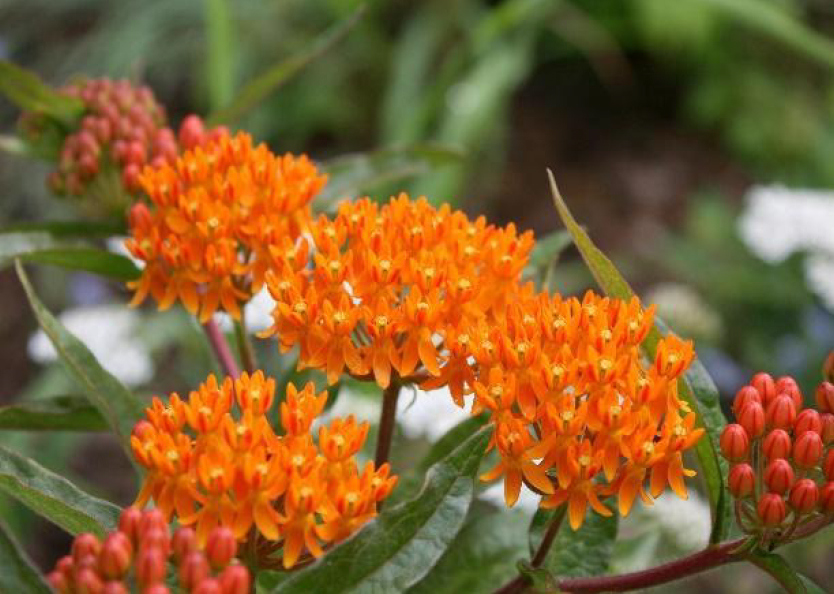
Asclepias viridiflora(Green Comet Milkweed) flower clusters form in the pocket created by the upper leaves. They’re made up of 20 to 80 small, pale green flowers. Interestingly, the yellowish-green leaves of this species vary in shape depending upon their habitat. Plants from moist sites tend to have rounder leaves, while plants from dry sites have long, narrow leaves. In the wild, this species is often found on shaded roadsides, savannas, and prairies with moist to dry soil. In the garden, you can grow Green Comet Milkweed from seeds. It grows best in light to moderate shade but will tolerate full sun. Medium-dry to dry soil is best. Green Comet Milkweed doesn’t need rich soil and will tolerate sandy or rocky soil with low organic matter. This species is a good choice for low-maintenance gardens as its long taproot allows it to tolerate drought well. Unlike many other milkweeds, this species is easy to prevent from spreading. It doesn’t form the large colonies typical to other milkweeds, so it’s an excellent option for smaller gardens!
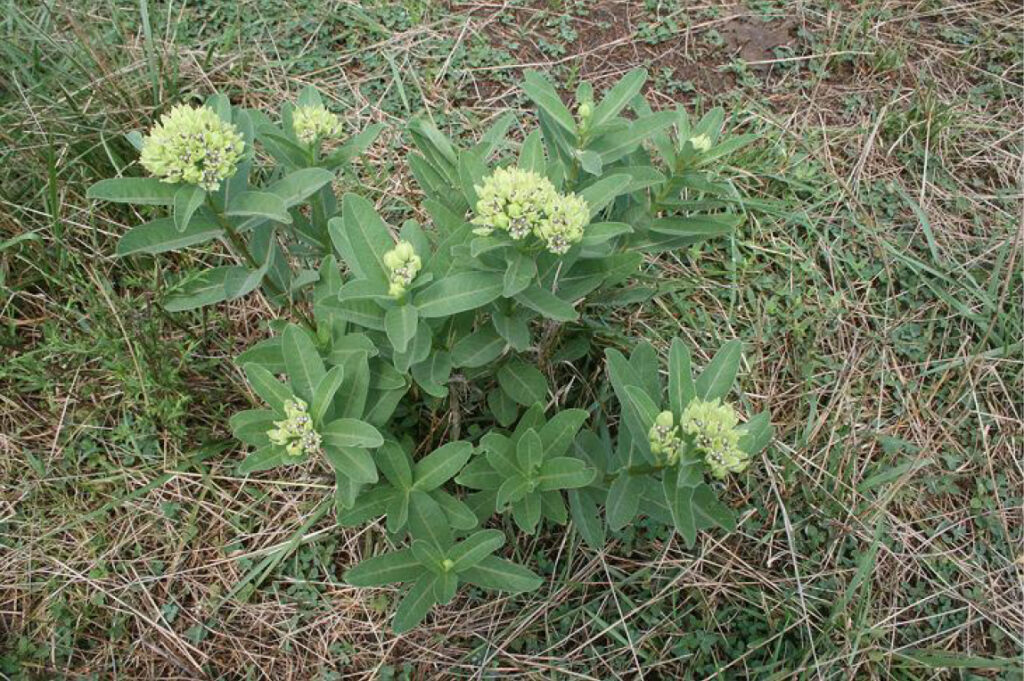
Asclepias exaltata (Poke Milkweed) flower clusters are pendulous, dangling from the plant like a weeping willow. They typically have about ten flowers, white with a green or lavender tinge. The leaves of the Poke Milkweed plant are dark green with purplish veins that stand out. Unlike many milkweed species in Mississippi, Poke Milkweed is often found in partial shade. This species can be grown in partial shade to full sunlight in the garden. It prefers soil with moderate moisture and rich organic material. It can be grown successfully in many home gardens and is easy to start from seed. Poke Milkweed is an excellent addition to any butterfly lover’s garden. It’s a host plant for the caterpillars of Monarchs. Its blooms also attract various other bees and butterflies.
Planting
Butterfly weed can grow anywhere in Mississippi as long where there is good drainage. Avoid areas where water pools. The closely related swamp milkweed is a good choice for wet areas. Swamp milkweed has flowers that are red to pink to white.
Maintenance
Especially where milkweed can overwinter, it’s recommended to cut plants back to the ground in the fall (September) so the Monarch butterflies will continue their migration to Mexico. This also helps hinder the spread of a protozoan parasite called OE (Ophryocystis elektroscirrha) that can harm the caterpillars.
Pests
One problem I’ve observed with the various milkweed species is aphid infestation. While unsightly, the aphids do not impact plant growth and flowering. I don’t recommend pesticides to remedy the aphid problem, but blasting the plants every couple of days with the garden hose does knock off many of the aphids.
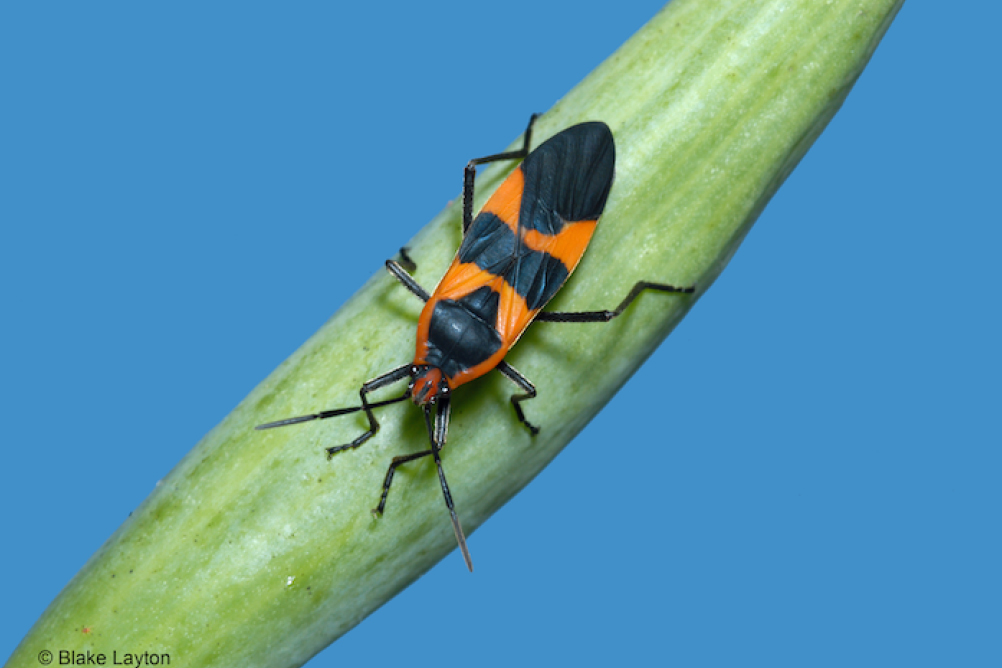
Large and small milkweed bugs may look like they are dressed for Halloween, but they are really dressed for defense. In nature this black and orange color combination usually signals danger or bad taste. Even the eggs are yellow to orange and easy to spot, but eggs also contain protective toxins. Milkweed bugs don’t normally bite, but they are distasteful to predators and cause illness in birds or mammals that eat them. Adult milkweed bugs range from ½ to ¾ inches long. Although they are usually found on various species of milkweed where they may occur in relatively large numbers, wandering adults are sometimes seen on other plants or locations. This is especially common in the spring when overwintered or migrating adults are searching for milkweed plants. Bugs from up north often overwinter in Mississippi and other Gulf States.
Pest Control
There is really no need to control milkweed bugs. Occasionally butterfly gardeners observe high populations of large milkweed bugs on milkweed plants growing in their butterfly garden, especially in late summer and fall. Although milkweed bugs can be killed by spraying with bifenthrin, zeta-cypermethrin, or similar products, such insecticides will also kill Monarch butterflies and their caterpillars. Fortunately, milkweed bugs feed mainly on the seed pods and even relatively high populations cause little real damage.

